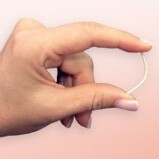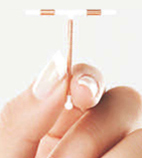If you are not planning on having children for several years, different forms of long-term birth control can eliminate the routine associated with birth control pills, rings, or shots. Long-term birth control methods are extremely convenient, safe, and effective.
Nexplanon®
 Nexplanon is a small, flexible birth control implant that is inserted under the skin of the arm. Nexplanon is about the size of a matchstick and can be left in place for three years. Most women cannot see the implant after it has been inserted. Nexplanon contains a hormone called etonogestrel and is more than 99 percent effective in preventing pregnancy. Because Nexplanon does not contain estrogen, it may be a suitable method of birth control for you if you cannot tolerate or should not use estrogen.
Nexplanon is a small, flexible birth control implant that is inserted under the skin of the arm. Nexplanon is about the size of a matchstick and can be left in place for three years. Most women cannot see the implant after it has been inserted. Nexplanon contains a hormone called etonogestrel and is more than 99 percent effective in preventing pregnancy. Because Nexplanon does not contain estrogen, it may be a suitable method of birth control for you if you cannot tolerate or should not use estrogen.
Nexplanon prevents pregnancy in several ways. The most important way is by preventing the release of an egg from your ovary. Nexplanon also changes the mucus in your cervix, which may keep sperm from reaching the egg, and changes the lining of your uterus.
Nexplanon removal
Nexplanon must be removed after three years. If you still desire long-term birth control after that time, your healthcare provider can insert a new implant after taking out the old one.
Nexplanon can be removed at any time if you decide you no longer wish to use it or want to become pregnant. After removal, your ability to get pregnant may return quickly. If you don’t want to become pregnant, you should start using another method of birth control immediately.
Nexplanon side effects
Like other forms of hormonal contraception, Nexplanon is associated with irregular menstrual bleeding. While using Nexplanon, you may experience more bleeding, less bleeding, or no bleeding. The time in between periods may vary, and you may experience spotting between periods. Other common side effects include headache, weight gain, acne, breast pain, abdominal pain, painful periods, nausea, dizziness, and mood swings.
IUD birth control
 The intrauterine device is a small T-shaped device that is inserted into the uterus. IUDs are approximately 99% effective in preventing pregnancy. Depending on your medical history and your expectations in birth control, your provider may suggest one type of IUD over another. There are hormonal and non-hormonal options available. Depending on the type of IUD, they can be left in place for 3-10 years. Your provider can help assist in finding the right IUD for your situation. Your options may include; Mirena®, Liletta®, Skyla®, Paragard® or Kyleena®.
The intrauterine device is a small T-shaped device that is inserted into the uterus. IUDs are approximately 99% effective in preventing pregnancy. Depending on your medical history and your expectations in birth control, your provider may suggest one type of IUD over another. There are hormonal and non-hormonal options available. Depending on the type of IUD, they can be left in place for 3-10 years. Your provider can help assist in finding the right IUD for your situation. Your options may include; Mirena®, Liletta®, Skyla®, Paragard® or Kyleena®.
